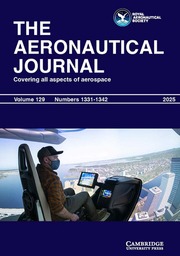Crossref Citations
This article has been cited by the following publications. This list is generated based on data provided by
Crossref.
Chakraborty, Imon
Jackson, David
Trawick, David R.
and
Mavris, Dimitri
2013.
Development of a Sizing and Analysis Tool for Electrohydrostatic and Electromechanical Actuators for the More Electric Aircraft.
Chakraborty, Imon
Mavris, Dimitri N.
Emeneth, Mathias
and
Schneegans, Alexander
2014.
A System and Mission Level Analysis of Electrically Actuated Flight Control Surfaces using Pacelab SysArc.
Chakraborty, Imon
Trawick, David R.
Mavris, Dimitri N.
Emeneth, Mathias
and
Schneegans, Alexander
2014.
A Requirements-driven Methodology for Integrating Subsystem Architecture Sizing and Analysis into the Conceptual Aircraft Design Phase.
Lawson, NJ
Gautrey, JE
Salmon, N
Garry, KP
and
Pintiau, A
2014.
Modelling of a Scottish Aviation Bulldog using reverse engineering, wind tunnel and numerical methods.
Proceedings of the Institution of Mechanical Engineers, Part G: Journal of Aerospace Engineering,
Vol. 228,
Issue. 14,
p.
2736.
Chakraborty, Imon
Mavris, Dimitri N
Emeneth, Mathias
and
Schneegans, Alexander
2015.
A methodology for vehicle and mission level comparison of More Electric Aircraft subsystem solutions: Application to the flight control actuation system.
Proceedings of the Institution of Mechanical Engineers, Part G: Journal of Aerospace Engineering,
Vol. 229,
Issue. 6,
p.
1088.
Akaydin, H. Dogus
Housman, Jeffrey A.
Kiris, Cetin C.
Bahr, Christopher J.
and
Hutcheson, Florence V.
2016.
Computational Design of a Krueger Flap Targeting Conventional Slat Aerodynamics.
Chakraborty, Imon
Mavris, Dimitri N
Emeneth, Mathias
and
Schneegans, Alexander
2016.
An integrated approach to vehicle and subsystem sizing and analysis for novel subsystem architectures.
Proceedings of the Institution of Mechanical Engineers, Part G: Journal of Aerospace Engineering,
Vol. 230,
Issue. 3,
p.
496.
Karthikeyan, S.
Ajay, G. Bharath
Ahamed, N. Raakin
and
Sharun, A.
2024.
Experimental and computational investigation of low Reynolds number aerodynamic characteristics of fixed wings relevant to micro air vehicle (MAVs).
Vol. 3037,
Issue. ,
p.
020021.

